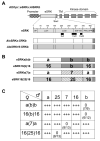In vivo detection of residues required for ligand-selective activation of the S-locus receptor in Arabidopsis
- PMID: 19375322
- PMCID: PMC2747293
- DOI: 10.1016/j.cub.2009.03.037
In vivo detection of residues required for ligand-selective activation of the S-locus receptor in Arabidopsis
Abstract
The self-incompatibility response of crucifers is a barrier to fertilization in which arrest of pollen tube development is mediated by allele-specific interactions between polymorphic receptors and ligands encoded by the S-locus haplotype. Activation of stigma-expressed S-locus receptor kinase (SRK) [1] by pollen coat-localized S-locus cysteine-rich (SCR) ligand [2-5] and the resulting rejection of pollen occurs only if receptor and ligand are encoded by the same S haplotype [4, 6-8]. To identify residues within the SRK extracellular domain (eSRK) that are required for its ligand-selective activation, we assayed chimeric receptors and receptor variants containing substitutions at polymorphic sites in Arabidopsis thaliana[9, 10]. We show that only a small number of the approximately 100 polymorphic residues in eSRK are required for ligand-specific activation of self-incompatibility in vivo. These essential residues occur in two noncontiguous clusters located at equivalent positions in the two variants tested. They also correspond to sites showing elevated levels of substitutions in other SRKs, suggesting that these residues could define self-incompatibility specificity in most SRKs. The results demonstrate that the majority of eSRK residues that show signals of positive selection and previously surmised to function as specificity determinants are not essential for specificity in the SRK-SCR interaction.
Figures



Similar articles
-
In vivo imaging of the S-locus receptor kinase, the female specificity determinant of self-incompatibility, in transgenic self-incompatible Arabidopsis thaliana.Ann Bot. 2015 Apr;115(5):789-805. doi: 10.1093/aob/mcv008. Epub 2015 Feb 24. Ann Bot. 2015. PMID: 25714818 Free PMC article.
-
Ligand-Mediated cis-Inhibition of Receptor Signaling in the Self-Incompatibility Response of the Brassicaceae.Plant Physiol. 2015 Oct;169(2):1141-54. doi: 10.1104/pp.15.00572. Epub 2015 Aug 12. Plant Physiol. 2015. PMID: 26269543 Free PMC article.
-
S-locus receptor kinase signalling.Biochem Soc Trans. 2014 Apr;42(2):313-9. doi: 10.1042/BST20130222. Biochem Soc Trans. 2014. PMID: 24646237 Review.
-
Structural modules for receptor dimerization in the S-locus receptor kinase extracellular domain.Proc Natl Acad Sci U S A. 2007 Jul 17;104(29):12211-6. doi: 10.1073/pnas.0705186104. Epub 2007 Jul 3. Proc Natl Acad Sci U S A. 2007. PMID: 17609367 Free PMC article.
-
Molecular mechanism of self-recognition in Brassica self-incompatibility.J Exp Bot. 2003 Jan;54(380):149-56. doi: 10.1093/jxb/erg007. J Exp Bot. 2003. PMID: 12456765 Review.
Cited by
-
Progress and Promise in using Arabidopsis to Study Adaptation, Divergence, and Speciation.Arabidopsis Book. 2010;8:e0138. doi: 10.1199/tab.0138. Epub 2010 Sep 29. Arabidopsis Book. 2010. PMID: 22303263 Free PMC article.
-
Self-incompatibility phenotypes of SRK mutants can be predicted with high accuracy.bioRxiv [Preprint]. 2024 Apr 11:2024.04.10.588956. doi: 10.1101/2024.04.10.588956. bioRxiv. 2024. PMID: 38645205 Free PMC article. Preprint.
-
Plant Lectins and Lectin Receptor-Like Kinases: How Do They Sense the Outside?Int J Mol Sci. 2017 May 31;18(6):1164. doi: 10.3390/ijms18061164. Int J Mol Sci. 2017. PMID: 28561754 Free PMC article. Review.
-
Arabidopsis and relatives as models for the study of genetic and genomic incompatibilities.Philos Trans R Soc Lond B Biol Sci. 2010 Jun 12;365(1547):1815-23. doi: 10.1098/rstb.2009.0304. Philos Trans R Soc Lond B Biol Sci. 2010. PMID: 20439283 Free PMC article. Review.
-
Self-incompatibility.F1000 Biol Rep. 2010 Sep 8;2:68. doi: 10.3410/B2-68. F1000 Biol Rep. 2010. PMID: 21173841 Free PMC article.
References
-
- Schopfer CR, Nasrallah ME, Nasrallah JB. The male determinant of self-incompatibility in Brassica. Science. 1999;286:1697–1700. - PubMed
-
- Kachroo A, Schopfer CR, Nasrallah ME, Nasrallah JB. Allele-specific receptor-ligand interactions in Brassica self-incompatibility. Science. 2001;293:1824–1826. - PubMed
Publication types
MeSH terms
Substances
Grants and funding
LinkOut - more resources
Full Text Sources
Molecular Biology Databases
Research Materials

